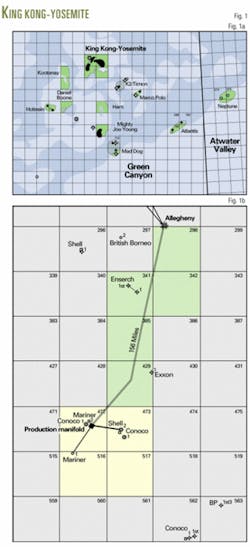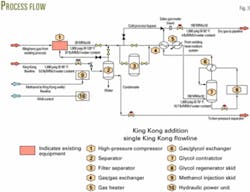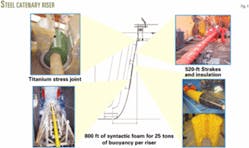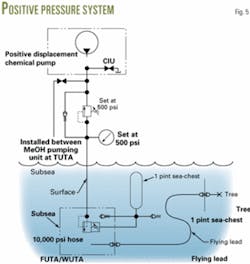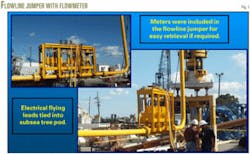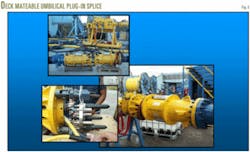The King Kong-Yosemite deepwater development project in the Gulf of Mexico (Fig. 1) involved several technologies that companies can implement either to make smaller deepwater projects commercial or to optimize larger projects better.
This project is the first in the Gulf of Mexico to include subsea wet-gas allocation meters. It also includes cold processing and standard thermoplastic hoses for the umbilical and relies on conventional rather than remote downhole switching of producing zones.
Mariner Energy Inc. and partners ENI Petroleum Co. Inc., and Noble Drilling Exploration Co. developed the fields.
The fields, in 3,700 ft of water, are tied-back 15 miles to the Allegheny mini-TLP host in 3,300 ft water.
Smaller projects
The Gulf of Mexico has many potential 10-50-million-boe deepwater projects. Development of these projects relies on a good understanding of the geology, reservoirs, and recovery mechanisms and requires a fit-for-purpose plan with acceptable risk capital.
These projects typically are subsea tiebacks that need a host infrastructure within a reasonable tieback distance.
Smaller projects depend on proven and enabling technology, leveraging the most from industry's research, development, and commercialization programs.
In a small field development, companies must carefully evaluate the risk and reward benefits of technologies.
Project history
The production manifold for the King Kong-Yosemite project (Fig. 2) is in Green Canyon Block 473. King Kong covers Blocks GC 472, 473, and 517 and Yosemite is in Block GC 516.
Conoco Inc., Texaco Inc., Mobil Corp., and AGIP SA discovered King Kong in February 1989. After several ownership changes, Conoco and Shell Exploration and Production Co. drilled an appraisal well in December 1991.
Subsequent to more ownership changes, Shell and British Borneo PLC started additional appraisal drilling in March 2000.
ENI acquired British Borneo, and Mariner acquired Shell's interest in King Kong. Later, the project expanded to include Yosemite, owned by Mariner and Noble Drilling Exploration Co.
The partners sanctioned the project in November 2000 soon after Mariner's August 2000 acquisition of Shell's interest. First production occurred in February 2002, 16 months after development started.
Mariner operated the project's development and installation phase and turned over operations to ENI in April 2002.
TLP tieback
King Kong-Yosemite produces gas and lean-condensate fluids, but some water production is expected later in the project's life.
The Allegheny mini-TLP, designed to process oil, has a nameplate capacity to handle 25,000 bo/d, 45 MMcfd of gas, and 10,000 bw/d, while the King Kong-Yosemite required a 150 MMcfd, 750 b/d condensate, and 500-bw/d process design.
The addition of this capacity involved many interface issues related to the host platform, such as platform weight, center of gravity, and space considerations.
The new and replacement process and control equipment on the TLP, including two test separators (one for each flowline), a small start-up heater, control systems, and methanol storage and injection facilities.
Each new separator has a 75 MMcfd, 400 b/d condensate, and 250-bw/d design capacity. For methanol handling, the project added two 400-bbl methanol storage tanks, four 2.9-gpm methanol pumps, and a condensate wash vessel for methanol contamination reduction.
The debottlenecking studies concentrated on dehydration capacity, future compression needs, and the flare system.
Maximum water content for gas export was 5 lb/MMcf, but the design target was 4 lb/MMcf.
Because a traditional warm separation, metering, and dehydration process design consumes much spare payload capacity and deck area, the design team for dewpoint control selected a cold process, otherwise known as low-temperature separation.
The cold process takes advantage of the 40° F. seabed temperature at the riser base that provides natural refrigeration of the hydrocarbons. Riser insulation keeps topsides flow arrival temperatures between 38 and 46° F. at the initial design flow rate.
The Joule-Thomson (J-T) pressure loss effect limits heat loss through the insulation, and cooler seasonal water column temperatures lower the arrival temperature, while temperatures are higher during warmer seasons.
Other factors affecting arrival temperature include flow rate, flowline operating pressure, and liquid content in the flow stream. Topside choking (J-T effect) can induce additional cooling, if required.
The King Kong-Yosemite production bypasses glycol dehydration.
At high flow rates, low process temperatures maintain an adequate dewpoint control. In practice during peak rates, operators have reported separation temperatures of about 36° F. and a dewpoint suppression to 2 lb/MMcf.
Flow-stream arrival temperatures will increase above the temperatures required to control dewpoint during late life when the fields produce at lower flow rates because of reserves and pressure depletion. At that time, the system chokes effectively are open.
At lower rates, the process will require either blending production or conventional dehydration for attaining the proper export dewpoint.
The cold process has the key benefit of reducing the conventional dehydration capacity. Fig. 3 shows a simplified version of the King Kong-Yosemite processing stream.
To date, including weather and compressor modifications, the subsea system and process have worked efficiently with more than 97% uptime.
Production peaked at 165 MMcfd and the 8-month plateau has averaged 160 MMcfd, 390 b/d of condensate, and 129 b/d of aqueous phase (water and methanol) dropout.
The design team selected steel catenary risers (SCRs) for the flowlines because of the water depth, pressure requirements, and vessel movements. The SCRs include titanium stress joints (Fig. 4) that mate into specially machined receptacles. The riser design has insulation, buoyancy, and strakes to suppress vortex-induced vibration (VIV).
The titanium stress joints are light weight, high strength, and fatigue resistant. An equivalent steel stress joint would weigh about four times more than a titanium joint.
The risers have subsea buoyancy to preserve some platform reserve buoyancy. The riser buoyancy also provides some insulation.
Umbilical considerations
The project included an all-thermoplastic hose umbilical design because of the similar bid prices for both hose and steel-tube designs including installation. Also Mariner has had good experience with these hoses. Two of the thermoplastic hoses were specially reinforced for high collapse resistance (HCR).
But after manufacturing and qualification of the hoses, the system integration testing of the entire subsea control system showed the unreliability of the HCR hoses.
To meet project production schedules and avoid replacing the entire umbilical, the project team reassigned the spare hydraulic thermoplastic hoses in the umbilical to serve as methanol supply and annulus relief lines. Because these were not collapse-resistant hoses, the design required a method to prevent collapse.
The team developed a positive pressure system (PPS) to ensure that the pressure differential between the methanol and seawater hydrostatic head would not collapse the thermoplastic methanol hoses (Fig. 5).
The PPS has high-quality, spring-loaded check valves at the surface and subsea ends of the hoses.
It is set always to lock in about 500 psig of pressure in the methanol hoses, a pressure slightly higher than the differential between seawater and methanol at the deepest point of the hose.
Collapse was not an issue during manufacture, test, and installation because the intended methanol lines contained hydraulic control fluid, a fluid denser than water. Collapse became an issue when methanol displaced the hydraulic fluid. This displacement was done from the platform after installation of the umbilical and hook-up to the PPS.
This was the first PPS in the Gulf of Mexico. It has been reliable in preventing collapse and proved that ordinary thermoplastic hoses could serve as deepwater methanol injection and annular relief lines.
Well completions
The King Kong-Yosemite well completions required frac packing for sand control.
The fields have stacked pay sands in two of the three wells. The King Kong (GC 472) discovery well has stacked pay and the Yosemite (GC 516) prospect had multiple stacked amplitudes identified.
Although statistics show that the industry has gained respect for intelligent completion (IC) reliability, ICs add complex equipment and installation procedures. Most IC installations contain complicated wellbore geometries and unforgiving debris tolerances.
Failure to execute these complex installations correctly subjects the project to serious overspending and, in this case, potential schedule clash with installation vessels.
Interventions in conventional selective completions also have risks, but these risks are less likely to affect the overall project.
The argument for IC completions instead of a conventional sliding sleeve is influenced largely by such factors as high deviation wellbores, ultradeepwater deep wells, or wells in which zones may be switched more than once.
Available low-cost subsea wireline systems can decrease considerably wireline intervention costs, even in very deep water.
The GC 472 completion has two productive intervals and the plan is to switch the zones only once through well abandonment.
The GC 516 well has two completed intervals of four potentially productive intervals. The plan is to switch zones only once before depletion. One of the two behind pipe intervals is uneconomical from the current wellbore. To access the other behind pipe interval, the plan is to recomplete the well conventionally or drill a sidetrack that intersects the intervals at a better location.
With the conventional selective approach, the operator reenters the well (installing a blowout preventer—BOP—on the tree, retrieving wireline plugs from the internal tree cap and tubing hanger) and then uses wireline tools to shift sliding sleeves to switch producing zones.
For a well with commingled production, wireline tools can close the sleeve and isolate a zone that may have high water-cut. In this case, reservoir monitoring includes a single surface-readout of downhole pressure and temperature from a sensor located just above the production packer.
During the project design stage, available vessels capable of wireline intervention included moored or dynamically positioned semisubmersible vessels or drilling rigs.
The IC approach had cost and timing benefits for interventionless commingling, zone switching, and zone isolation for zones producing high water cuts. This was an important consideration because of the limited methanol injection capacity.
In the IC approach, a subsea control pod applies hydraulic pressure through a downhole control line for remote operation of the sliding sleeves. This approach also allows the monitoring of pressure and temperature outside each sliding sleeves and inside the tubing, sensing the differential across each sleeve before opening the sleeve, and monitoring of the reservoir pressure in a shut-in zone.
If the hydraulic controls failed, wireline intervention could still shift the sleeves.
Early in the project design, justification for IC focused on production-management issues, operability advantages, system reliability, and reservoir and production engineering pros and cons. Various reservoir models simulated different completion configurations and operating conditions with various levels of aquifer support and rock compaction.
The studies showed that commingling reservoirs in the same wellbore accelerated production and reduced the contrast in producing pressures during the project's later life. On the other hand, commingling made reservoir management more difficult because individual zone performance and productivity becomes ambiguous. Commingling also complicates decisions regarding when to add compression and how much horsepower to install.
Production profiles for the commingled cases indicated that a successful, well-managed IC installation would provide better project economics.
The team ordered the subsea trees, because of their long lead times, with sufficient ports to accommodate IC. These extra ports could be blanked off easily if further analysis determined not to use the IC approach.
A successful IC approach is better than a conventional completion if the analysis includes the intervention cost with a semisubmersible vessel.
Offsetting this is the complexity of installing an IC system and the mechanical risks and challenges during a workover if there are problems with the installation, a packer leak, or a sand-control failure.
Access to the tubing ID is required for releasing most IC packers. This is problematic if a well has a horizontal subsea tree or there is an obstruction high in the tubing.
The project team's evaluation also included risk and sensitivity analysis on the effect of an IC on the project schedule, long-lead equipment, tree modifications, subsea controls, and completion equipment. In particular, they examined installation risk, including time and motion analysis. This analysis had two key parts.
The first part was the cost and risk differences between an IC and a conventional completion. The cost differences included the up-front design, manufacture, and integration procedures associated with an IC compared to the later intervention costs for conventional completions. A particular focus was the differences in rig time associated with completion steps common to both the IC and conventional completion.
Although the actual increment in rig time required to install the IC was only a few extra hours to pick-up and run the IC assembly, the risked time was markedly longer for an IC if there was a problem, such as spaceout problems or a connection failure.
A simple completion program is more likely to be completed within the budget considering fewer steps, fewer tools to malfunction, and fewer things to go wrong.
The analysis identified significant potential savings with the conventional completion approach, and reality bore this out.
Completion of the three wells conventionally cost $26 million, $11 million under budget. One of the stacked completions in 3,800 ft of water took only 17 days from first anchor out to last anchor bolstered. Removing complication saves time and reduces the risk of a significant time over-run.
Another consideration was the narrow time window for rig activities and its impact on construction and production start. As scheduled, the pipeline and umbilical lay and subsea construction started after the rig finished the completions and left the field.
The lay vessel has a less-flexible schedule that could clash with the rig if the completion program became protracted. In this case, the rig would have to cease completion operations, secure the well, pull the BOP stack and riser, and winch off location to allow the lay barge to enter its anchor spread.
The estimated impact was several million dollars and could delay the start of production.
Mariner uses a business model that is more risk averse, so that a delay of first gas has a direct and tangible effect on present value.
Cost overruns squeeze out other high impact exploration and exploitation projects.
Planned intervention later in the life of the project can have similar effects but usually on a smaller scale because only one well is at risk rather than the entire project.
The industry on some IC completions, decompletions, and reinstallations has had cost overruns in 10s of millions of dollars.
As a result of this comprehensive risk analysis, the team selected conventional completions with future subsea interventions for zone changes instead of IC or commingled configurations.
Zone changes with a rig or multiservice vessel (MSV) were planned for late 2003.
Because of the high costs and risks of subsea interventions with a semisubmersible vessel, Mariner pursued lower-cost ways for wireline interventions with monohull MSVs and a subsea wireline lubricator system.
To date, Mariner has successfully reentered four subsea wells at a fraction of the cost of a semisubmersible. The lower day-rates of monohull MSVs and their new wireline capabilities considerably diminished the life-cycle benefits of the IC approach.1
Table 1 compares the costs of these approaches.
Intervention and IC system costs are lower than when King Kong-Yosemite was analyzed. Each new application adds to the track record, system reliability, and pros and cons for each approach. Thus, each potential application must be evaluated with respect to project risks and the dynamics of changing costs, technology and reliability.
Fig. 6 shows the GC 472 completion.
Subsea meters
Subsea wet-gas meters provide accurate gas measurements at high gas-void fractions (GVF). These meters are applied best in systems that can be periodically calibrated with conventional test separator measurements.
The installation of the meters only requires typical offshore construction techniques and times without complicated procedures. The systems have had excellent service reliability.
During pre-sanctioning, the project team worked on an allocation methodology for production from various leases, different zones, and fields with different federal royalty burdens and working interest ownership. Also this complex subsea system has production management issues.
Project economics did not allow the installation of separate flowlines from each lease to the host facility. The project was based on a production manifold and subsea commingled production from wet-gas reservoirs.
The King Kong Federal Unit, formed in May 1993, joined three leases with two different federal royalty burdens but with the same owners. Had the project involved only these leases, unit allocation of production would satisfy fiscal and regulatory concerns.
The project, however, also included one half of the Yosemite lease. Yosemite has one additional federal royalty type and different lease owners.
Application for and approval of an amended unit would entail a lengthy process with project schedule and allocation point implications. Nevertheless, this process proceeded.
It was uncertain, however, whether the unitization and commingling the different fields would be approved. As it turned out, the amended unit was approved by April 2001, 10 months before first production.
Another development, Canyon Express, planned to apply subsea wet-gas metering in early 2000.2 The initial timeline of meter qualification testing and regulatory approvals fit the King Kong-Yosemite project timeline. Thus, the King Kong-Yosemite project investigated using these same meters.
The King Kong-Yosemite project team ordered and installed Solartron ISA Control's Dualstream II meters for each subsea well (Fig. 7). These meters were similar to those being qualified for Canyon Express.2
The meter measures gas and total liquid flowrate. Gas, condensate, water, and methanol components are computed in real time.
It was decided to include the meters as part of the flowline jumpers that connect the subsea trees to the subsea manifold or infield flowline end terminations.
Because they are in the jumpers, one can retrieve the meters for service or replacement with a small work class MSV and without disturbing the trees, manifold, pipelines or requiring the suspension of production from all wells.
The individual meters were calibrated by comparing the subsea wet-gas measurements with King Kong-Yosemite test separator measurements on the TLP
During the initial 6 weeks of production, each King Kong well flowed in a separate flowline, providing a long period for testing the subsea meters. The two wells produced close to the system capacity.
Production stabilized within the subsea meter's accuracy range.
Yosemite commenced production in the seventh week in one dedicated flowline with the two King Kong wells sharing the other flowline. The field remained in this configuration for the next 6 months.
Yosemite production stabilized at three fourths of flowline capacity during this period.
Isolating one well in a dedicated flowline allows the calibration of any of the subsea meters.
The subsea wet-gas meters have satisfactory accuracy for gas flow allocation. The relative difference in gas flowrate measurements for the King Kong subsea meters compared with the separator measurements ranged between +2 to +4%, indicating an over-estimation by the subsea meters.
The Yosemite subsea flowmeter had a relative difference of ±2%.3
The production stream is normally too dry for the meters to measure liquid flow rates with acceptable accuracy. The gas void fraction (GVF) for reservoir fluids without free water ranges from 99.5 to 99.9% for the three wells at meter conditions.
Laboratory test of the wet-gas meters indicated that the liquid measurement accuracy deteriorates above 98% GVF.3 If free water increases, GVF will decrease and the measurement accuracy of the liquid should improve.
Flowmeter installation was successful and the meters did not complicate the installation process of jumpers. The meters have had excellent service reliability.
Manifold location
The primary development plan includes six proven reservoirs in different depositional sequences within the Plio-Pleistocene.
They had different original pore pressures and are subject to various depletion drive mechanisms.
Production profiles and facility management of such decisions as compression horsepower upgrades depend on how the reservoirs are commingled. Field architecture strongly determines production performance because the production is gathered to and distributed from the subsea manifold down the main flowlines.
To optimize field production performance, the project team studied manifold placement and infield flowline sizing. Other important considerations were equipment needs, installation, and commissioning scope.
The team evaluated four field layouts and constructed commingled production models of the subsea system and host facilities. These models connect the reservoir models to the host process facility through export operating conditions.
By simulating models in time while accounting for depletion and changing facility operating conditions, the team generated production profiles for the various field layout configurations.
The study used Schlumberger GeoQuest's Petrel for the earth models for export to Schlumberger GeoQuest's ECLIPSE reservoir simulator, and then PIPESIM's Field Planning Module used the ECLIPSE reservoir output to generate production profiles.
To select the best manifold location and infield flowline sizes, the team emphasized the system and facility capacity goals, the length of production time at this capacity, and cumulative production in the first 5 years.
Furthermore, the production profiles would identify remedies to significant system constraints (infield flowline sizes) and adverse commingling interference between wells.
The study considered both line and coiled pipe. The options were nominal 5-in. line and coiled pipe and 6-in. line pipe.
The best result was for placing the manifold next to King Kong GC 472 with 5-in. infield flowlines. There was little difference between centralized manifold cases and this location. Locating the manifold next to GC 473 resulted in less production than other locations.
Furthermore, also noted were adverse interference effects between GC 516 and GC 472.
The manifold placement decision factored in flow assurance, production profiles evaluations, and configuration cost data into complex economic analysis.
By locating the manifold adjacent to GC 472 vs. a centralized local, the projects realized significant equipment, installation and commissioning scope, and costs advantages.
Infield tieback flowlines were with 5-in. line pipe.
Manifold installation
The design included a manifold landed on a fixed subsea pile. Initially the plan was to deploy the manifold from the semisubmersible drilling and completion rig through the moon pool with the derrick.
During the project field schedule planning, the design team determined that deploying the manifold from a less-expensive, dynamically positioned (DP) boat would save significantly rig time.
They left rig deployment as an option if weather prevented sensible and safe deployment from the boat.
The rig did install the 36-in. conductor pipe for the manifold pile. This early pile installation allowed the DP boat to have a wide weather window for the manifold installation. The boat deployed the manifold easily without needing heave compensation equipment.
A surface adjustment oriented the manifold to match the remote operated vehicle (ROV) measured orientation of the mating orientation helix on the pile.
Subsea pigging
Two of the subsea wells required individual infield flowlines, while the third has a jumper directly to the manifold.
The infield lines are not in the overall pigging loop system and thus these lines had to be pigged, gauged, and dewatered from subsea end to subsea end before being hooked up to the subsea trees and manifolds.
The flowline end terminations have hubs that easily allow vertical connectors on the flowline jumpers to be made up and disconnected with an ROV.
These types of hubs also connect the flowline jumper at the subsea trees.
A subsea pig launcher and receiver enable the connection of surface lines for pumping water, hydro testing, and pumping nitrogen.
The surface lines can be hooked up easily with an ROV after installation of the pig launcher.
Plug-in splice
The umbilical included five separate field splices because of its length, cross-section size, and overall weight on the selected installation vessel.
Field splices typically are time consuming and require testing and correct wiring while the umbilical is draped over the overboard shoot.
This process increases the opportunity for umbilical damage, additional vessel costs, and incorrect wiring or plumbing of hoses in the cross section.
The job required development of a quick-connect splice (Fig. 8) based on the standard field proven junction plates that are used routinely for intervention workover control systems (IWOC's) and flying leads. This allowed laying down the umbilical with a quick-connect pull head and then quickly stabbing in with the next umbilical section after pick up.
Factory acceptance tests (FAT) and system integration tests (SIT) of these splices eliminated the need for extended deck testing of new splices.
The splice design allowed them to be plugged together only in one correct way, thus eliminating the chance of incorrectly hooking up hoses or wires.
Urethane sleeves
The umbilical installation required two subsea crossings of the production flowlines. The crossings used urethane sleeves instead of concrete mats because it was felt that the urethane sleeves would save costs in pre-crossing preparations. Concrete mats provide 9 in. of separation between flowline and umbilical.
The sleeves worked well but were time consuming to apply to the umbilical.
The extra boat time cost for adding the urethane sleeves was about equivalent to the cost of preinstalling concrete crossing mats.
Performance to date
The project costs were $19 million under the $161 million budget. Most of the savings came from a simplified completion scope and efficient rig operations. The project achieved a payout in 11 months.
Production uptime and performance has exceeded expectations. Actual uptime is 97% net of weather and planned compression upgrade shut-in. Typical uptime assumptions for subsea projects vary between 90 and 95%.
Production averaged 160 MMcfd during an initial 8-month plateau (12% above capacity less assumed downtime).
The project had no lost time accidents or environmental incidents.
Acknowledgments
The authors thank Mariner Energy Inc., ENI Petroleum Co. Inc., and Ocean Flow International LLC for permission to publish this article.
References
1. Fisher, W.F., et al., "Case History: Using Multi-Service Vessels for Plug & Abandonment of Subsea Wells, Subsea Tree Installation, and Pipe Remediation," DOT, Marseille Nov. 19-21, 2003.
2. Wallace, B.K., et al., "Canyon Express Subsea Multiphase Flow Metering System: Principles and Experience," OTC, Houston, May 5-8, 2003.
3. Saether, G., et al., "Subsea Wet Gas Flowmeters for Mariner Energy's King Kong and Yosemite Fields," submitted for publication to Offshore.
Based on a presentation to the Deep Offshore Technology Conference, Marseille, France, Nov. 19-21, 2003.
The authors
Cory Loegering ([email protected]) is vice-president of deepwater development for Mariner Energy Inc., Houston, and is responsible for the development of Mariner's deepwater assets including commercial and economic analysis. He previously worked in the planning, reservoir, production, and projects disciplines with Conoco Inc., Tenneco Inc., and Hardy Oil and Gas Inc. Loegering holds a BS in civil engineering from Montana State University.
Tom Campbell is manager deepwater petroleum engineering for Mariner Energy Inc. He has served in various team leadership roles across numerous project development phases. Most of his recent assignments have focused on high profile reservoir and flow-assurance engineering positions on deepwater projects. Campbell has a BS in petroleum engineering and a BS in chemical engineering from Texas A&M University.
Karl Winter is deepwater project manager for Mariner Energy. Winter holds a BSc in engineering from Trinity College Dublin, a production engineering degree from Dublin Institute of Technology, an ocean engineering degree from University College London, an MSc in ocean engineering from University of London, and a MBA from University of Aberdeen.
Filippo Maioli is a reservoir project manager with AGIP Petroleum Co. Ltd. He currently is in charge of development, production optimization, reserves, and production budget for several Gulf of Mexico fields. Previously he worked at the ENI reservoir study center in Milan coordinating Italian and International reservoir studies. Maioli has an MS in geological science from the University of Milan.

